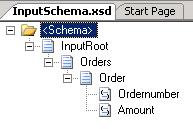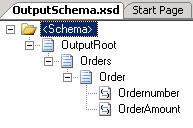Hi
Every now and then, I come across the need of adding a node to the output of a BizTalk map.
Now, if I just want to add some node which isn't dependent on the input, I can just use a custom scripting functoid which is an XSLT template that just craeted the node for me, like this:

Use the "Inline XSLT Call Template" instead, if you need parameters to your XSLT.
BUT, sometimes I need to add a node to a list of existing nodes. One example of this I came across was the need to have a log inside the XML structure that was updated every time BizTalk touched the document. So there would be a structure inside the XML like this:
<TheLog>
<LogEntry>This is the first log entry and it was added by Jan</LogEntry>
<LogEntry>This is the second entry and it was added by BizTalk</LogEntry>
</TheLog>
So BizTalk needed to add a line to TheLog when BizTalk mapped the document.
Another example is a guy on the microsoft.public.biztalk.general newsgroup that needs to add an OrderItem to an existing list of OrderItems.
To do this, I have only found one solution, which is a custom xslt script that does the whole thing.
My example input schema:

My example output schema:

In both schemas, the "Order"-element can occur multiple times.
The map looks like this:

Basically, just one scripting functoid. Note that no links go from the source document. The scripting functoid is a "Inline XSLT" type, and the source is this:
<xsl:for-each select="//Orders/Order">
<xsl:element name="Order">
<xsl:element name="Ordernumber"><xsl:value-of select="Ordernumber" /></xsl:element>
<xsl:element name="OrderAmount"><xsl:value-of select="Amount" /></xsl:element>
</xsl:element>
</xsl:for-each>
<xsl:element name="Order">
<xsl:element name="Ordernumber">400</xsl:element>
<xsl:element name="OrderAmount">40</xsl:element>
</xsl:element>
Basically, the for-each creates line in the output according to the input XML document. And the xsl:element after the for-each creates the new node.
You can find my BizTalk 2006 project here: AddingANode.zip (16,89 KB) - it should work with BizTalk 2004 as well.
I hope this has helped someone. Comments are welcome.
--
eliasen